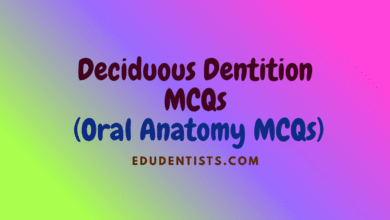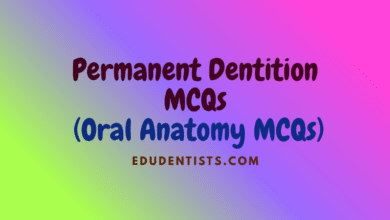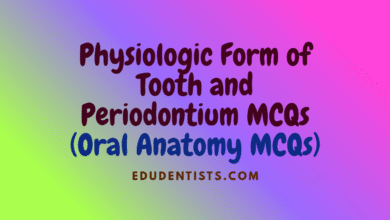Oral Anatomy MCQs
Calcification and Eruption of Teeth MCQs

Calcification and Eruption of Teeth MCQs
- The correct dentition in a 9- years old child is:
A. 12CDE6
B. 12C456
C. 123DE6
D. 123456 - Once the enamel formation is complete, the tooth will erupt after approximately:
A. One year
B. Two years
C. Three years
D. Four years - Calcification of all teeth except last molars are completed by:
A. 2 years
B. 4 years
C. 6 years
D. 8 years - The time taken for primary tooth root completion after eruption:
A. 3 years
B. 1 years
C. 2 years
D. 1 month - Calcification of third molar begins at:
A. 8 months
B. 18 months
C. 8 years
D. 16 years - A 6- years – old child, received tetracycline. Noticeable discoloration will be seen in:
A. Premolars, incisors and 1st molars
B. Canine and 2nd molars
C. Canines, premolars and2nd molars
D. Incisors and 1st molars - What is the amount of time required by erupting premolar to move through 1 mm of bone as measured on a bite – wing radiograph?
A. 3-4 months
B. 4-5 months
C. 5-6 months
D. 6-7 months - Eruption date of deciduous maxillary 2nd molar is?
A. 20 months
B. 18 months
C. 24 months
D. 28 months - Number of teeth seen on X- ray at birth?
A. 20
B. 22
C. 24
D. 30 - Which of the following is dental formula of a 9 years old child?
A. 6 EDC21/ 6EDC21
B. 6EDCBA/ 6EDC21
C. EDC21/EDC21
D. 76EDC21/ 7EDC21 - First evidence of initiation of primary dentition is usually around?
A. 4 months in utere
B. Birth
C. 4 months after birth
D. One year after birth - Generally in majority of children, the sequence of eruption of permanent teeth in mandible is?
A. 1-6-2-3-5-4-7-8
B. 6-1-2-4-5-3-7-8
C. 6-1-2-3-4-5-7-8
D. 6-1-2-4-3-5-7-8 - A radiograph of 4- years old child reveals no evidence of calcification of mandibular second pre molar. This indicates?
A. It is too early to make final predication
B. The teeth may develop later
C. Primary second molar extracted to allow mesial drifting of permanent first molar
D. The child may never develop premolars - The most common sequence of eruption of the permanent maxillary teeth in children is?
A. 1-6-2-3-4-7-5-8
B. 2-3-1-6-7-5-4-8
C. 6-1-2-4-3-5-7-8
D. 6-1-2-3-4-5-7-8 - The deciduous canine emerges?
A. Before lateral incisor
B. Before first molar
C. After first molar
D. After second molar - Calcification of roots of deciduous teeth is completed by:
A. 2 years
B. 4 years
C. 6 years
D. 8 years - The eruption are of maxillary permanent lateral incisor is:
A. 8-9 years
B. 6-7 years
C. 10-11 years
D. 8-9 months - In anxious parent calls you that her 5- month -old child has still no teeth in his mouth then you should:
A. Call and do radiographic survey
B. Tell her that it is normal at this age
C. Child has retarded growth
D. Systemic problem - First permanent molars begin to calcify at:
A. 6 months of intra utrerine life
B. At birth
C. Before decidous incisors
D. About 1 year after birth - Maxillary primary cuspid enamel completion takes place at:
A. 6 months in utero
B. 6 months after birth
C. 9 months in utero
D. 9 months after birth - The tooth bud for the third molar is initiated at about the age of:
A. 6th month I.U
B. 1st year of life
C. 2nd year of life
D. 8th year of life - The first macroscopic indication of morphologic development of primary incisors approximately at:
A. 11 weeks in utero
B. 14 weeks in utero
C. 16 weeks in utero
D. 6 weeks in utero - A new tooth is erupting in the mouth of a one and a half year old child. This tooth is most likely to be a deciduous:
A. Maxillary central incisor
B. Mandibular lateral incisor
C. Maxillary lateral incisor
D. Maxillary canine - The first evidence of calcification of primary anterior teeth begins approximately between:
A. 14 to 17 weeks in utero
B. 9 to 12 weeks in utero
C. 6- to 9 weeks in utero
D. 17 to 20 weeks in utero - Which of the following is true about calcification of teeth:
A. Calcification of primary teeth is almost complete at time of birth
B. Calcification of all primary teeth and few permanent teeth complete at birth
C. Calcification of all permanent teeth complete at birth
D. Calcification of primary teeth starts around birth - The process of exfolitation of primary teeth is between:
A. Seventh and eight years
B. Seventh and ninth years
C. Seventh and tenth years
D. Seventh and Twelfth years - The teeth that are retained for the longest period of time are:
A. Maxillary incisors
B. Maxillary canines
C. Mandibular incisors
D. Mandibular canines
E. B & D - Beginning of eruption of permanent tooth starts:
A. After completion of root
B. When apical third root is still to be formed
C. When half of the root is still to be formed
D. when root formation starts - Root completion of the mandibular first molar takes place by the age:
A. 7-8 years
B. 8-9 years
C. 9-10 years
D. 10 – 11 years - First evidence of calcification of maxillary permanent central incisors occurs at:
A. 3-4 months
B. 10-12 months
C. 2-3 years
D. 3-4 years - Primary canine erupts:
A. After D
B. Before B
C. After B
D. After E - In the majority of situations, the first deciduous tooth to erupt is the:
A. Mandibular central incisor
B. Mandibular first molar
C. Maxillary central incisor - Which of these teeth are highly sturdy and usually the last ones to be lost:
A. First molar
B. Central incisors
C. Canines
D. Premolars - Before eruption the position of permanent mandibular incisor buds relative to primary incisors is:
A. Superior and facial
B. Inferior and facial
C. Superior and lingual
D. Inferior and lingual - The root completion of permanent teeth is achieved after ___________ years of eruption:
A. 1-1½
B. 2-3
C. 3-4
D. 4-5 - Growth of all permanent teeth except last molars is completed by:
A. 6 years
B. 8 years
C. 12 years
D. 17 years - Which of the following gives the best description of erupted permanent teeth typically seen in a 9- years old?
A. Only molars
B. All teeth except third molars
C. 1,2,4,5,6,7 in all quadrants
D. 1,2,6 in all quadrants - A six- year molar begins to calcify at:
A. Six months IU
B. At birth
C. 1 years after birth
D. 3 years age - As compared to permanent tooth , root formation in primary tooth:
A. Take less time
B. Take more time
C. Same time
D. Is complete when tooth erupts in oral cavity - At birth the following teeth are calcifying:
A. Primary incisors & first molar
B. Primary canines & second molars
C. Permanent canines
D. Permanent 3rd molar - A child has 12 permanent and 12 decidous teeth, what is his age:
A. 8½ years
B. 11½ years
C. 4½ years
D. 13½ years - Dentition of humans is:
A. Herbivorous
B. Omnivorous
C. Carnivorous
D. None of the above - While charting the dentition of a child, the pedodontist finds that the following teeth are present in all the four quadrants; permanent central incisor , permanent lateral incisor , deciduous cuspid , deciduous first molar, deciduous 2nd molar and permanent 1st molar. The eruptive pattern may be considered most nearly normal for a child aged:
A. 3-6 years
B. 7-10 years
C. 11-14 years
D. 15- 18 years - The first permanent tooth to erupt in the oral cavity is the:
A. Mandibular central incisor
B. Mandibular first molar
C. Maxillary central incisor
D. Maxillary first molar - The usual order of appearance of the primary teeth in the mouth is:
A. Central incisors, first molars, lateral incisors, second molars, canines
B. Central incisors, lateral incisors, canines, second molars, first molars
C. Central incisors, lateral incisors, first molars canines, second molars
D. Central incisors, lateral incisors, first molars second molars, canines - Calcification of permanent first molar usually begins in the:
A. Third month of intrauterine life
B. In the sixth month of intrauterine life
C. At birth
D. In the third month of extra uterine life - The last primary tooth to be replaced by a permanent tooth is usually the:
A. Maxillary second molar
B. Mandibular second molar
C. Maxillary canine
D. Mandibular canine



